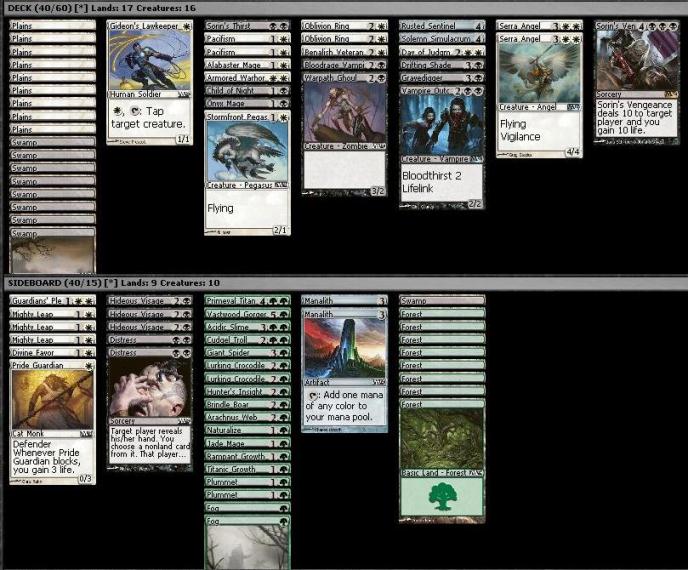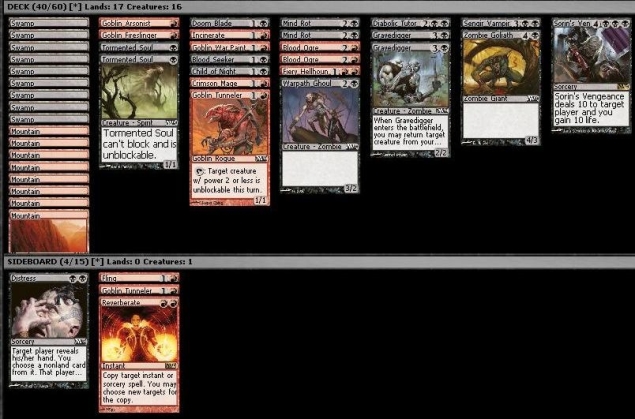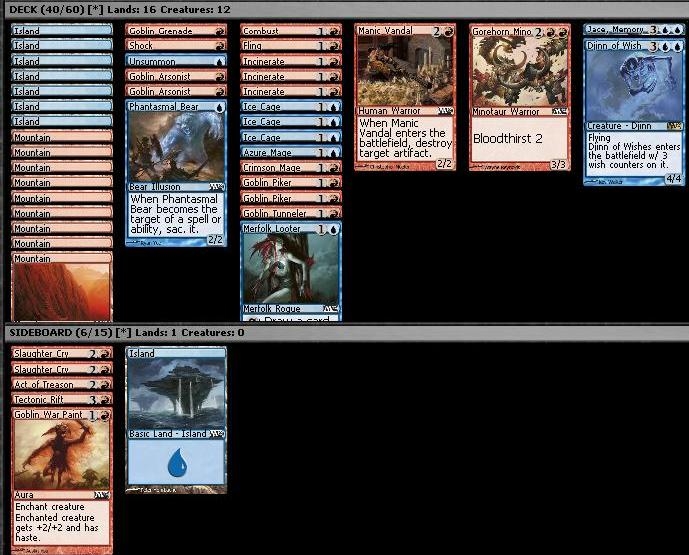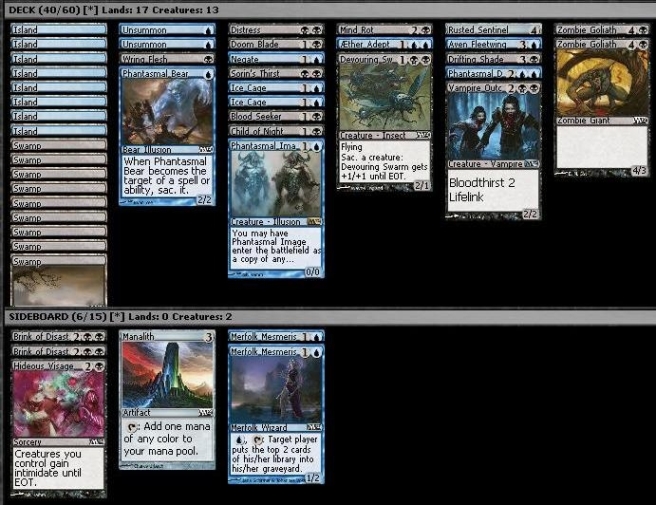Day One Highlights
“Now pass to the left again…” Every eye at the table was on me. To say that the gentleman diagonally across from me had been vocal about his “ridiculous” card pool—Rune-Scared Demon, Grave Titan, Flameblast Dragon, a dozen black removal spells—would be an understatement. And I was now holding it in my hands. My brother, looking at me from across the table, had a smile so big he might have just come from the Queen of Hearts’ Croquet Field. Just as I couldn’t hold my breath for a second longer, though, the judge finally continued, “now pass left a third time, and this will be your deck.”
We weren’t allowed to take out the cards yet, but I snuck a peak at the “White” section of my decklist and knew right away that everything would be okay. For easy reference, I’ve provided an image of the deck I submitted and my relevant sideboard cards.

The strength of the deck was in white, and blue and red were immediately out. Beyond that, though, there were plenty of interesting choices to be made. Black and green both did a nice job of filling out the deck; green offered the stronger creature base and removal while black had other appeals, not the least of which were Sorin’s Vengeance and Gravedigger. I took the full amount of time deciding between W/B and W/G.
What put the W/B build over the top for me was the presence of Day of Judgment. The card is extremely powerful, and I knew that it would play a central role in many of my games. The W/G build is just a creature deck, so any time I swept the board, I would have to stop in my tracks and start mounting an offense again from scratch. On the other hand, Gravedigger plays great with Day and was the single best card for me in games that went long. What’s more, simply having Sorin’s Vengeance in the deck generally meant that all I would have to do to win is survive until I could draw and cast it. I could get in some early damage, sandbag Day of Judgment as long as possible, and finish, when I was ready, with my bomb rare.
I decided, however, that I would sideboard into green whenever I faced a blue deck. Lurking Crocodile goes from efficient to “must-kill-right-away” when the opponent has Islands; Plummet is live as removal for blue fliers; Naturalize answers Mind Control, which is the reason most players would go blue in Sealed; and Sorin’s Vengeance could get countered against a blue deck anyway. It’s nice when your sealed pool has two builds that are very close in strength because the simple act of changing your deck can throw off your opponent’s sideboarding and gameplay. The sideboard changes worked out great. Fittingly, the only game I lost on Day One was when my opponent—B/G to start—secretly sideboarded in blue so that I didn’t know to bring in the green for game two.
In retrospect, I did make one very clear mistake in deckbuilding: I should have played Distress over Rusted Sentinel. I don’t feel bad about my decision because when you’re unsure between a creature and a noncreature in Limited, you should always go with the creature. My regret was not testing Distress enough before the tournament. The reality of the card is that it’s quite mediocre in most situations. However, when your goal is to beat 7-1 or 8-0 sealed decks, any way to answer an opposing bomb is very welcome. My mistake wasn’t costly as my friends convinced me to sideboard a Distress in for the matches where I stuck to W/B.
Round 5 (at 4-0): Ian Duke
My brother and I had seen one another’s sealed pools, and it was clear that mine was the stronger of the two. Nevertheless, I had no illusions about this match. Everybody’s heard of “card advantage” and “tempo advantage,” but people like me know that there’s also something called “big brother advantage” which, while harder to measure, is no less powerful in its ability to determine a game.
Ian attacked his Amphin Cutthroat into my Serra Angel four times, and after I went down to twelve, he played out the last card in his hand—Stampeding Rhino. He had had nothing all along! I can’t explain how he matched my Serra Angels and Oblivion Rings with his Brindle Boars and Arachnus Webs, but he pulled it off, and both games came down to topdecks. I narrowly escaped this one with my life.
Round 6 (at 5-0): Raphael Levy
Up a game, I had a good start for the second with two creatures right off the bat. Raphael Levy played Cudgel Troll but wasn’t surprised when I Oblivion Ringed it. On his turn, he tapped out and slammed a Pentavus. For the first time in the match, he showed emotion—disgust—when I played my second Oblivion Ring. Not to be outdone, though, he followed up with Garruk, Primal Hunter, to which I had no answer. Since I had been stuck on three lands, my creatures were too weak to get through the first Beast token, and after that all Hell broke loose.
The game seemed to be slipping out of my control, but I maintained hope because of the Day of Judgment in my hand, which my esteemed opponent hadn’t seen in game one. I’d never seen anyone decline to use Garruk’s ultimate at the first opportunity, so I could hardly control my pounding heart when he untapped with six loyalty. Unfortunately, Raphael Levy isn’t “anyone.” The master surveyed the board and then, in a display of great generosity, gave the spectators and myself a glimpse into his thought process. “What would happen if you had Day of Judgment?” he muttered, “What would happen if you had Serra Angel? What would happen if you had Sorin’s Vengeance?” As it was, I had all three! My heart sank when he bumped his planeswalker up to seven and then flooded the board with a Giant Spider to protect Garruk and a Brindle Boar to put him out of range of Sorin’s Vengeance.
All I could do was play my Angel and pass the turn. Before using Garruk’s ultimate, he attacked me with his army of Beasts. I knew that I needed to keep enough creatures to threaten a counter swing, but as I debated my blocks, Levy said to me “you’re not winning this game; let’s save time for the next one…” I struggled to meet his gaze, “Maybe not, but I’m sure going to play it out.” I blocked and Garruk put seven 6/6 Wurm tokens into play.
Finally I had to use Day of Judgment, leaving me with nothing and him with only Garruk. I played a Rusted Sentinel so that I could eventually block, and then a Drifting Shade so I could attack back. Faced with a tough decision, I decided to go straight for Levy rather than Garruk so I could put him at ten life. Naturally, my play tipped him off that I had Sorin’s Vengeance in my hand, so he used Garruk to draw three cards, looking for an answer. A multitude of cards flashed through my head: Mind Rot, Distress, Brindle Boar, Sorin’s Thirst, Gravedigger would all put the game out of my reach, but I dodged them all, and Sorin’s Vengeance finished him off.
Round Seven (at 6-0): David Ochoa
“Going on tilt” is a common phrase in MTG and describes how people play worse when they’re upset; the opposite can also happen. At this point in the tournament I was 6-0—nearly a lock for day two—and confident in my deck. I was overly excited, and I was playing faster and looser than I normally do. Basically, I was used to winning and expecting to win, so I was beginning to rush when a win was in sight.
It’s not that I was playing badly—I could never have beaten an opponent like David Ochoa if I had been. As he put it himself, I was being “emotive.” I won game one by attacking with creatures but had a big Sorin’s Vengeance finish in game two. Mr. Ochoa said to me, “It seemed like you had that in game one also?” which I indeed did. I asked him how he knew, and he told me that, among other things, I seemed anxious and was looking at my lands differently than usual.
It’s critical to remain composed and placid at all times, regardless of your emotions. Never is this truer than when you face a more experienced opponent; they’ll pick up on any clues you drop.
Draft #1
I finished day one 9-0, and my first draft was covered by Bill Stark. Here’s an image of the deck as well:

This deck looks good on paper, but it has weaknesses. There’s not enough removal to answer fliers, and it’s also not fast enough to reliably race them. I kept losing to Chasm Drakes and Skywinder Drakes.
There was a crucial pick in pack two where I took Tormented Soul over Sorin’s Thirst. At the time I was building a mono-red hyper-aggressive deck and figured that if I played black at all, it would be with something like six Swamps. After that, red dried up, and I picked up Mind Rots and Gravediggers and was left wishing I had the Thirst almost more than any other card. I ended up with a 1-2 record in the first draft.
Draft #2

My first pick of pack one was Azure Mage, but it seemed clear that the person to my right was in blue, so the rest of my picks were red. In pack two, I opened Incinerate and Jace, Memory Adept and had to decide between passing the bomb and having one of my colors badly cut in pack three. Finally, I decided on Jace, and it turned out well for me. For one thing, I opened Djinn of Wishes in pack three. For another, Jace, Memory Adept is really good…
I won the first two rounds and found myself in fifth place going into the final round. Under normal circumstances, players next to each other in the standings get paired in the last round so that intentional draws work out more smoothly. However, in a draft tournament, you can only be paired against a player in your pod, so things can get a little hairy. I was paired against Sam Black, who was in 10th place, and we had to play it out.
I won the first game, and he chose to draw in game two. I led with Crimson Mage; he with Child of Night, and I played Azure Mage on turn 3. Mr. Black attacked with his Child, and I traded Crimson Mage. I had stumbled into dangerous territory, though, as having one creature to zero meant Smallpox could take out my Azure Mage at no loss. Fortunately, I had Unsummon to protect the Mage, and after the Smallpox crippled us both, the stream of card advantage from her eventually put the game away for me.
Top Eight Draft

I wasn’t on the Brink of Disaster, but this draft was painfully mediocre for me. Everything that could go wrong did go wrong. My first three picks were black cards, and by the time I realized Alex West, to my right, was black, I was unwilling to give them up. Based on an Azure Mage and a Merfolk Looter going by early, and a Phantasmal Dragon late, I misread that blue was open and chose it as my second color when the players on my left and my right both ended up blue.
I could have salvaged the draft by moving into green, but I’m not sure at what point I should have done so. Green is the weakest color in M12, and I don’t like to go into it before having a premium card. I knew that green was open, but only because I was seeing packs with Runeclaw Bears or Stampeding Rhinos with no other playable cards. Even if green was wide open, there was a risk that I could move into it only to end up with a deck full of average, vanilla creatures anyway, if the right cards weren’t opened.
It was only in pack three—much too late—that I saw a card that could have put me into green. Imagine being locked into U/B and being passed a pack, pick three, with Overrun, Pacifism, and Incinerate! At this point I knew the odds were stacked against me…
In the end I went out in the quarterfinals, but I considered the tournament a huge success. The biggest lesson I learned is to take things one game at a time. Grand Prix are long tournaments, and they inevitably have highs and lows for everybody who goes deep. After my strong start, I felt pressure building to finish well, and starting day two with back-to-back losses was crushing for me. Don’t lose your focus when nothing is going your way, or, on the flip side, when everything is at once. One minute you can be facing Garruk with seven loyalty, but you can never quite be sure what the next minute will bring.
